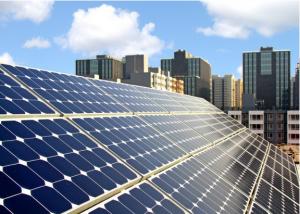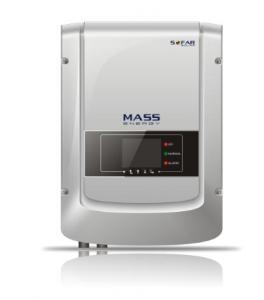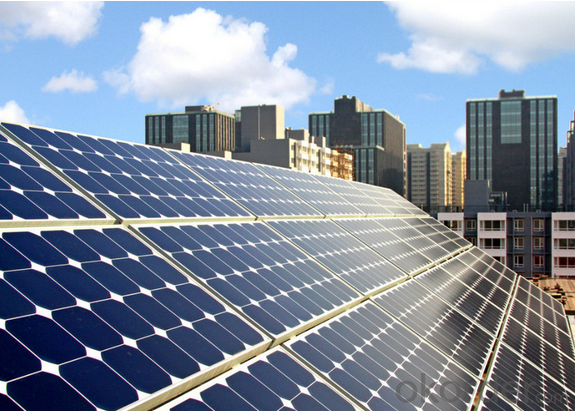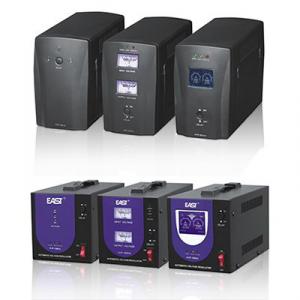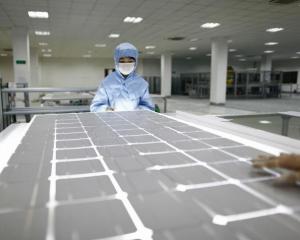Sunpower Solar Inverter 3000w Grid-Tied Solar PV Inverter 3000TLM
- Loading Port:
- Shekou
- Payment Terms:
- TT or LC
- Min Order Qty:
- 10 unit
- Supply Capability:
- 99999 unit/month
OKorder Service Pledge
OKorder Financial Service
You Might Also Like
3000W Grid-tied Solar PV Inverter 3000TLM
High-yield
•Max 97.6%efficiency
•Real timeprecise MPPT algorithm for max harvest
•Wide inputvoltage operation range from 100V to 550V
•Two MPPtrackers for flexible PV panel configuration
3000W Grid-tied Solar Inverter Low maintenance cost
•Rust-freealuminumcovers
•Flexiblemonitoring solution
•Multifunctionrelay can be configured to show various inverter information
3000W Grid-tied Solar Inverter Flexible and economicalsystem solution
•Free siteselection due to IP65
•Easy installationand maintenance due to “Plug & Play” connection
•Interfaceselection-Wi-Fi/RS485/DryRelay for more flexible configuration and system monitoring
•4” LCDdisplay
3000W Grid-tied Solar Inverter Intelligent grid management
•Reactivepoweradjustable
•Self powerreducerwhenover frequency
•Remoteactive/reactivepower limit control
3000W Grid-tied Solar Inverter Datasheet
Technical Data | SOFAR 3000TLM | SOFAR 3680TLM | SOFAR 4000TLM | SOFAR 4600TLM | SOFAR 5000TLM |
Input (DC) | |||||
Max. Input Power | 3100W | 3800W | 4160W | 4800W | 5200W |
Max. DC power for single MPPT | 2000 (200V-500V) | 2400 (200V-500V) | 2600 (200V-500V) | 3000 (200V-500V) | |
Number of independent MPPT | 2 | ||||
Number of DC inputs | 1 for each MPPT | ||||
Max. Input Voltage | 600V | ||||
Start-up input voltage | 100V(+/-5V) | ||||
Rated input voltage | 360V | ||||
Operating input voltage range | 100V-550V | ||||
MPPT voltage range | 160V-500V | 165V-500V | 175V-500V | ||
Max. Input current per MPPT | 10A/10A | 12A/12A | 13A/13A | 15A/15A | |
Input short circuit current per MPPT | 12A | 14A | 16A | 18A | |
Output(AC) | |||||
Rated power(@230V,50Hz) | 3000VA | 3680VA | 4000VA | 4600VA | 5000VA |
Max. AC power | 3000VA | 3680VA | 4000VA | 4600VA | 5000VA |
Nominal AC voltage | L/N/PE, 220, 230, 240 | ||||
Nominal AC voltage range | 180V-270V | ||||
Grid frequency range | 44~55Hz / 54~66Hz | ||||
Active power adjustable range | 0~100% | ||||
Max. Output Current | 13A | 16A | 17.5A | 20A | 22A |
THDi | <3% | ||||
Power Factor | 1(Adjustable +/-0.8) | ||||
Performance | |||||
Max efficiency | 97.6% | ||||
Weighted eff.(EU/CEC) | 97.1%/97.3% | ||||
Self-consumption at night | <1W | ||||
Feed-in start power | 20W | ||||
MPPT efficiency | >99.5% | ||||
Protection | |||||
DC reverse polarity protection | Yes | ||||
DC switch | Optional | ||||
Protection class / overvoltage category | I/III | ||||
Input/output SPD(II) | Optional | ||||
Safety Protection | Anti-islanding, RCMU, Ground fault monitoring | ||||
Certification | CE, CGC, AS4777, AS3100, VDE 4105, C10-C11, G83/G59 (more available on request) | ||||
Communication | |||||
Power management unit | According to certification and request | ||||
Standard Communication Mode | Wifi+RS485 | ||||
Operation Data Storage | 25 years | ||||
General data | |||||
Ambient temperature range | -25℃ ~ +60℃ | ||||
Topology | Transformerless | ||||
Degree of protection | IP65 | ||||
Allowable relative humidity range | 0 ~ 95% no condensing | ||||
Max. Operating Altitude | 2000m | ||||
Noise | <25dB | ||||
Weight | 18kg | ||||
Cooling | Nature | ||||
Dimension | 344×478×165mm | ||||
Warranty | 5 years | ||||
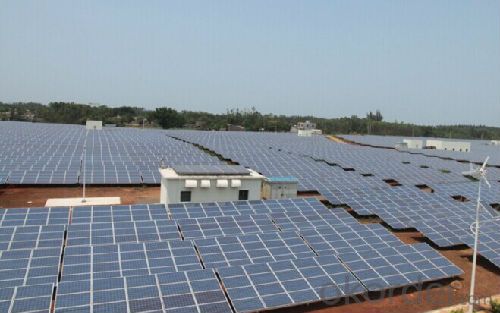

- Q: What is the expected lifespan of a solar inverter?
- The expected lifespan of a solar inverter typically ranges between 10 to 20 years.
- Q: What is the role of voltage regulation in a solar inverter?
- The role of voltage regulation in a solar inverter is to ensure that the energy generated by the solar panels is converted and delivered to the electrical grid or used within a premises at a stable and appropriate voltage level. It helps to maintain the quality and consistency of the electricity output, protecting the connected devices and ensuring optimal performance of the solar power system.
- Q: What is the efficiency loss of a solar inverter over time?
- The efficiency loss of a solar inverter over time depends on various factors such as the quality of the inverter, maintenance practices, and environmental conditions. Generally, high-quality inverters experience a minimal efficiency loss, typically around 0.5% to 1% per year. However, if the inverter is poorly maintained or subject to harsh conditions, the efficiency loss could be higher. Regular maintenance and monitoring can help mitigate efficiency loss and ensure optimal performance.
- Q: What is the efficiency rating of a solar inverter?
- The efficiency rating of a solar inverter refers to the percentage of solar energy converted into usable electricity. It measures how effectively the inverter converts the direct current (DC) power generated by solar panels into alternating current (AC) power for use in homes and businesses. Higher efficiency ratings indicate that the inverter can convert a greater amount of solar energy, resulting in increased electricity production and cost savings.
- Q: How does the total harmonic distortion affect the performance of a solar inverter?
- Total harmonic distortion (THD) refers to the distortion in the waveform of an electrical signal caused by the presence of harmonics. In the case of a solar inverter, high levels of THD can negatively impact its performance. Excessive THD can lead to voltage and current waveform distortions, which can result in various issues such as reduced power quality, increased losses, and decreased efficiency of the solar inverter. These distortions can also affect the overall performance and lifespan of connected electrical devices, potentially leading to their malfunction or premature failure. Therefore, it is crucial to ensure that a solar inverter maintains low levels of THD to optimize its performance and minimize any adverse effects on the connected electrical systems.
- Q: Can a solar inverter be used with a solar-powered telecommunications system?
- Yes, a solar inverter can be used with a solar-powered telecommunications system. A solar inverter is essential in converting the direct current (DC) generated by solar panels into alternating current (AC) required for powering telecommunication equipment. This ensures efficient and reliable operation of the system by enabling the utilization of solar energy to power the telecommunications infrastructure.
- Q: Can a solar inverter be used with a solar-powered heating system?
- Yes, a solar inverter can be used with a solar-powered heating system. A solar inverter converts the DC power generated by solar panels into AC power that can be used for various applications, including heating systems. By connecting the solar inverter to the solar panels and the heating system, the generated solar power can be efficiently utilized to provide heat for the system.
- Q: Can a solar inverter be used in systems with different module currents?
- Yes, a solar inverter can be used in systems with different module currents. Solar inverters are designed to convert the DC power generated by solar panels (modules) into AC power that can be used by electrical devices. They are typically equipped with Maximum Power Point Tracking (MPPT) technology, which allows them to optimize the power output from the solar panels regardless of their current ratings. This means that solar inverters can efficiently handle systems with different module currents and ensure the maximum power generation from the solar panels.
- Q: Can a solar inverter be used with a solar carport?
- Yes, a solar inverter can be used with a solar carport. A solar inverter is responsible for converting the direct current (DC) produced by the solar panels into usable alternating current (AC) electricity. This AC electricity can then be used to power various devices or fed back into the grid. In the case of a solar carport, the solar panels installed on the carport structure generate DC electricity, which is converted by the solar inverter into AC electricity to charge electric vehicles or power other electrical systems in the carport.
- Q: Are there any safety considerations when installing a solar inverter?
- Yes, there are several safety considerations when installing a solar inverter. Firstly, it is important to ensure that the inverter is installed by a qualified professional who is familiar with local electrical codes and regulations. This helps to minimize the risk of electrical hazards and ensures a safe installation. Additionally, proper grounding and bonding should be implemented to protect against electrical shock and lightning strikes. Adequate ventilation and temperature management are also important to prevent overheating and potential fire hazards. Overall, following safety guidelines and employing professional installation services are crucial to ensure the safe and efficient operation of a solar inverter system.
Send your message to us
Sunpower Solar Inverter 3000w Grid-Tied Solar PV Inverter 3000TLM
- Loading Port:
- Shekou
- Payment Terms:
- TT or LC
- Min Order Qty:
- 10 unit
- Supply Capability:
- 99999 unit/month
OKorder Service Pledge
OKorder Financial Service
Similar products
Hot products
Hot Searches
Related keywords
